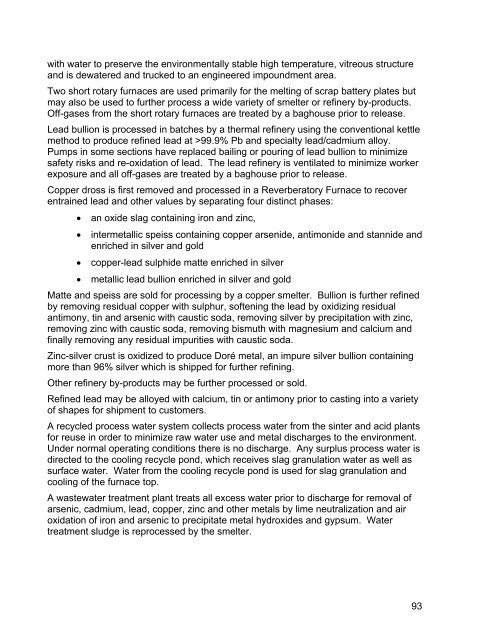(MERAF) for the Base Metals Smelting Sector - CCME
(MERAF) for the Base Metals Smelting Sector - CCME
(MERAF) for the Base Metals Smelting Sector - CCME
Create successful ePaper yourself
Turn your PDF publications into a flip-book with our unique Google optimized e-Paper software.
with water to preserve <strong>the</strong> environmentally stable high temperature, vitreous structure<br />
and is dewatered and trucked to an engineered impoundment area.<br />
Two short rotary furnaces are used primarily <strong>for</strong> <strong>the</strong> melting of scrap battery plates but<br />
may also be used to fur<strong>the</strong>r process a wide variety of smelter or refinery by-products.<br />
Off-gases from <strong>the</strong> short rotary furnaces are treated by a baghouse prior to release.<br />
Lead bullion is processed in batches by a <strong>the</strong>rmal refinery using <strong>the</strong> conventional kettle<br />
method to produce refined lead at >99.9% Pb and specialty lead/cadmium alloy.<br />
Pumps in some sections have replaced bailing or pouring of lead bullion to minimize<br />
safety risks and re-oxidation of lead. The lead refinery is ventilated to minimize worker<br />
exposure and all off-gases are treated by a baghouse prior to release.<br />
Copper dross is first removed and processed in a Reverberatory Furnace to recover<br />
entrained lead and o<strong>the</strong>r values by separating four distinct phases:<br />
• an oxide slag containing iron and zinc,<br />
• intermetallic speiss containing copper arsenide, antimonide and stannide and<br />
enriched in silver and gold<br />
• copper-lead sulphide matte enriched in silver<br />
• metallic lead bullion enriched in silver and gold<br />
Matte and speiss are sold <strong>for</strong> processing by a copper smelter. Bullion is fur<strong>the</strong>r refined<br />
by removing residual copper with sulphur, softening <strong>the</strong> lead by oxidizing residual<br />
antimony, tin and arsenic with caustic soda, removing silver by precipitation with zinc,<br />
removing zinc with caustic soda, removing bismuth with magnesium and calcium and<br />
finally removing any residual impurities with caustic soda.<br />
Zinc-silver crust is oxidized to produce Doré metal, an impure silver bullion containing<br />
more than 96% silver which is shipped <strong>for</strong> fur<strong>the</strong>r refining.<br />
O<strong>the</strong>r refinery by-products may be fur<strong>the</strong>r processed or sold.<br />
Refined lead may be alloyed with calcium, tin or antimony prior to casting into a variety<br />
of shapes <strong>for</strong> shipment to customers.<br />
A recycled process water system collects process water from <strong>the</strong> sinter and acid plants<br />
<strong>for</strong> reuse in order to minimize raw water use and metal discharges to <strong>the</strong> environment.<br />
Under normal operating conditions <strong>the</strong>re is no discharge. Any surplus process water is<br />
directed to <strong>the</strong> cooling recycle pond, which receives slag granulation water as well as<br />
surface water. Water from <strong>the</strong> cooling recycle pond is used <strong>for</strong> slag granulation and<br />
cooling of <strong>the</strong> furnace top.<br />
A wastewater treatment plant treats all excess water prior to discharge <strong>for</strong> removal of<br />
arsenic, cadmium, lead, copper, zinc and o<strong>the</strong>r metals by lime neutralization and air<br />
oxidation of iron and arsenic to precipitate metal hydroxides and gypsum. Water<br />
treatment sludge is reprocessed by <strong>the</strong> smelter.<br />
93
















